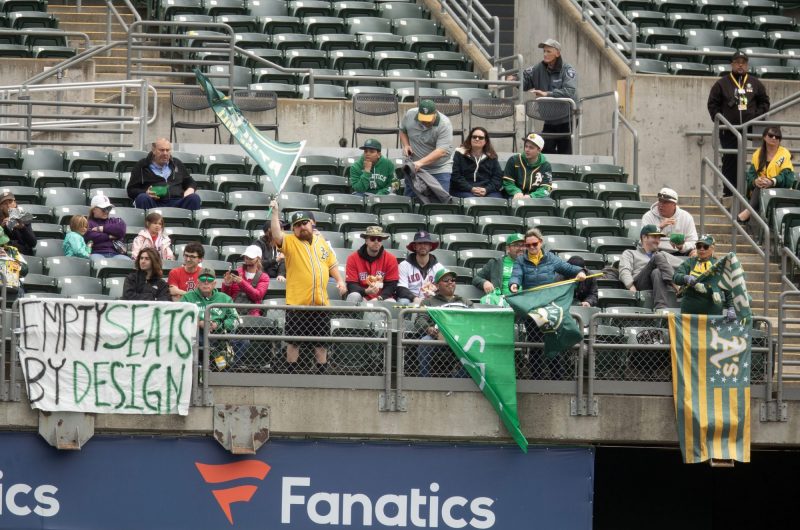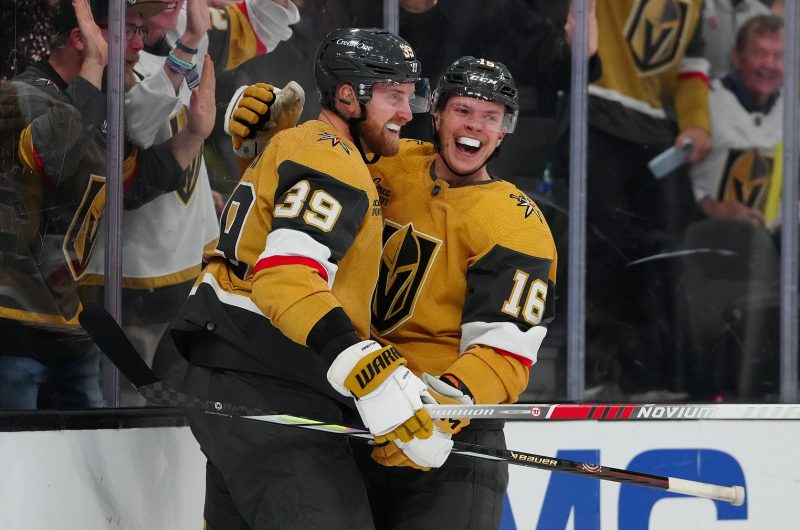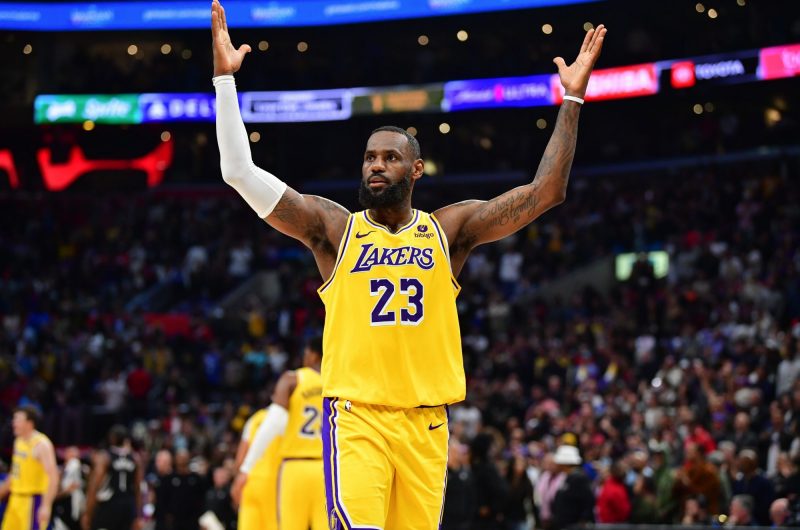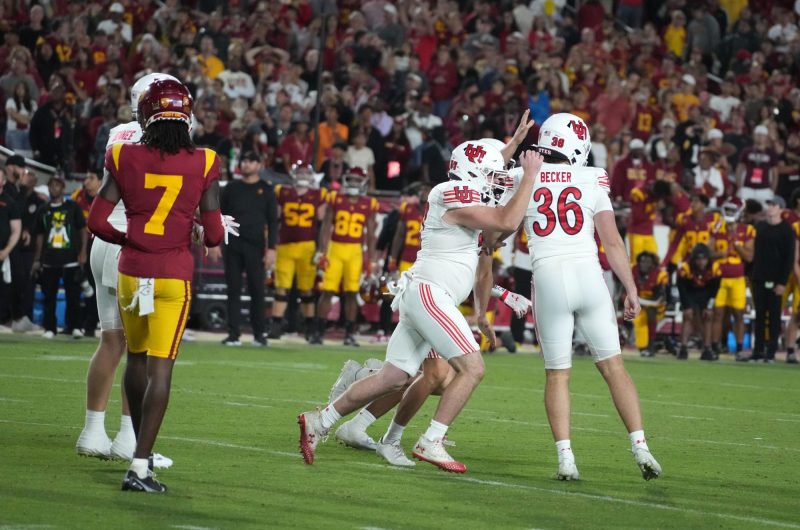Hello everyone, welcome to The Sporting Tribune’s coverage of the Anaheim Ducks. Myself, Felix Sicard, CJ Woodling, and Derek Lee are excited to provide you with in-depth coverage of the Ducks that you will not be able to find elsewhere.
The season has gotten off to a rocky start for the Ducks, with the team amassing 7 points (3W-6L-1OTL) in 10 games, and having a -18 goal differential, but when you dig a bit deeper past the surface level there is room for optimism with this team, not only for the future but also this season.
As a note, there will be advanced metrics cited throughout this article like Corsi and Expected Goals. I highly suggest going to the following primer from Charlie O’Connor of the Athletic if you are not familiar with these terms, but to give a quick synopsis of these stats, they try to capture what happens between the goals and help to evaluate which team was driving the play throughout the game.
The Schedule
The first big reason that patience will be key after the start of the season is that the Ducks faced a tough schedule. As of writing this article, seven of the ten teams that the Ducks have faced are in the top half of the league in terms of 5v5 xGF% (expected goals for%), and five of those seven are in the top eight teams in the league and in addition to that, the Ducks had to instantly go on an East Coast road trip and play a lot of those tough matchups. To put it simply, the Ducks had a very tough road ahead of them to start the season and it showed in their record and their 42% xGF% at 5v5. At best, the team this year would be a middle-of-the-pack team that squeaks its way into the playoffs and has a fun run, and teams in that position struggle to beat and control play against the better teams in the league while racking up points against weaker opponents.
Games eleven through twenty will help provide a more in-depth picture of who this Ducks team is. Seven of those ten games come against teams that are in the bottom half of the league.
The Young Stars Thrive
Coming into the season, two of the biggest questions surrounding the Ducks were would there be a sophomore slump for Trevor Zegras, and was Troy Terry’s breakout season actually a blip on the radar? The answer so far this season is a resounding no.
From a box score perspective, Terry has 4 goals and 8 assists for 12 points in 10 games, and Zegras has 6 goals and 2 assists for 8 points in 10 games. From an advanced metrics perspective, Zegras and Terry are the only two Ducks forwards that sit above 50% xGF%, and both are top 5 on the team in xGF/60 and xGA/60, which means that when these guys are on the ice the Ducks are generating a larger amount of quality looks for than against, which is pivotal to winning hockey games consistently.
Terry has found his success this year by being one of the most direct players on the team upon entering the zone. He consistently is putting pressure on opposing team defenders and forces his way into the high slot area where he then can unleash his lethal shot.
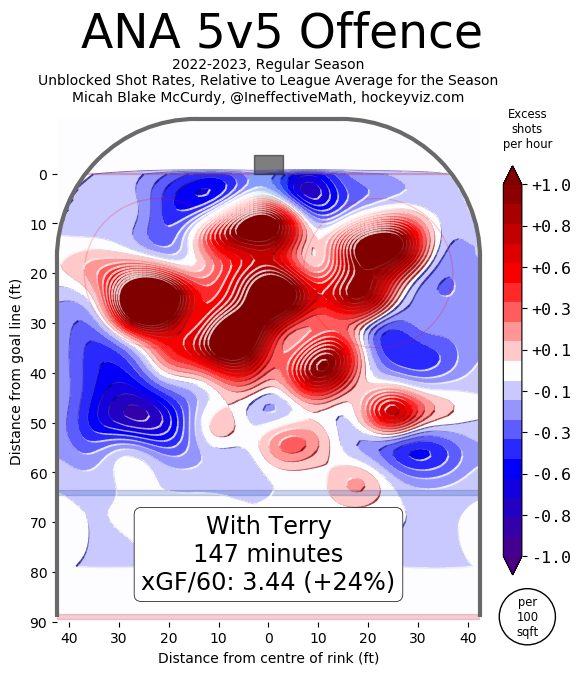
Trevor Zegras on the other hand uses his skill and hockey IQ in a much different manner, but the end result is once again dangerous looks for the Ducks. Zegras uses deception and change of speeds to open up passing lanes and create shots from the slot.
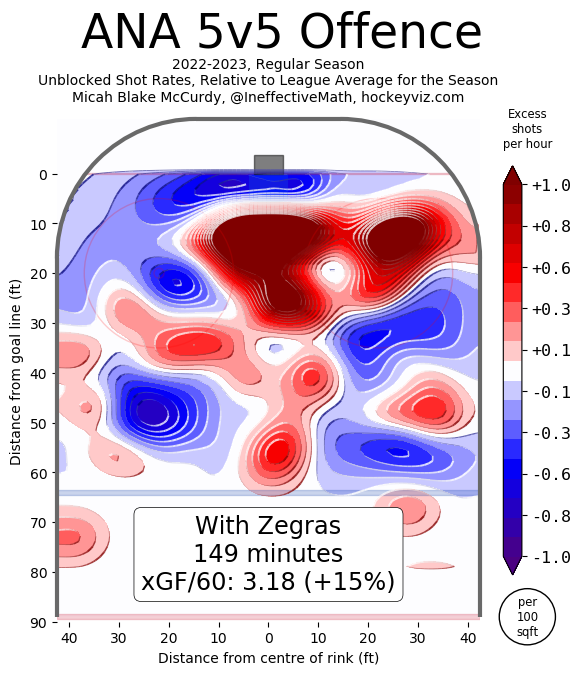
Both of those images show that when Zegras or Terry is on the ice, the Ducks are generating more chances than the league average from the inner slot.
These two players have not only stepped up to the task of producing with all eyes on them, but they are also creating a ton of offense. These two present a glimpse into not only what can be an extremely fun season, but also a very bright future.
The Issues are Fixable
With all of that being said, there are still glaring issues with this team. The good news is that these issues are fixable. From an offensive perspective, the Ducks through their first nine games really struggled to find any form of secondary scoring and offensive zone pressure. If the line with Zegras and Terry on it was not on the ice, the Ducks really suffered to create any form of offense and as a result of that, those lines would be caught defending for long stretches of time. The talent is there on the secondary lines, but for various reasons they could not put it together over the early portion of the season.
There are signs though that this issue has been addressed already. Against the Sharks, the lines were shuffled and Terry found himself on a line with Max Comtois and Ryan Strome, and Zegras was on a line with Frank Vatrano and Adam Henrique, and these changes worked. Those two lines controlled the shot attempt share, expected goal share, and were on the ice for 2 goals for each. Having two lines that can control play and create offense can quite literally be a game changer for the Ducks.
The other major issue is the special teams’ play. The Ducks’ currently have the 31st ranked powerplay and the 31st ranked penalty kill, and the underlying metrics are not that much better. The Ducks are 27th in the league in terms of generating quality chances for on the powerplay (6.21 xGF/60), and they are 28th in the league in terms of limiting quality chances against on the penalty kill (10.03 xGA/60).
On the power play, the Ducks run a very stationary unit that is working for a one-timer from the outside, whereas the more successful power plays in the league have movement from the players to find holes in coverage to work for a quality shot. By being so stationary, the Ducks have become predictable and easy to defend.
On the penalty kill, an easy fix would be an adjustment to the players that are used. The team has defaulted to using the traditional penalty killer types that are known for making “safe” plays and blocking shots, while the more successful teams have started to utilize more skilled players along with these guys on penalty kills. Even if it is contrary to traditional hockey logic, these high skilled players have a high hockey IQ and they can be extremely successful in this role as a result.
This team is certainly not perfect but fun times are ahead in Duckland this season, so keep your eyes here for in depth coverage of the team.
All statistics courtesy of evolving-hockey.com unless noted otherwise



